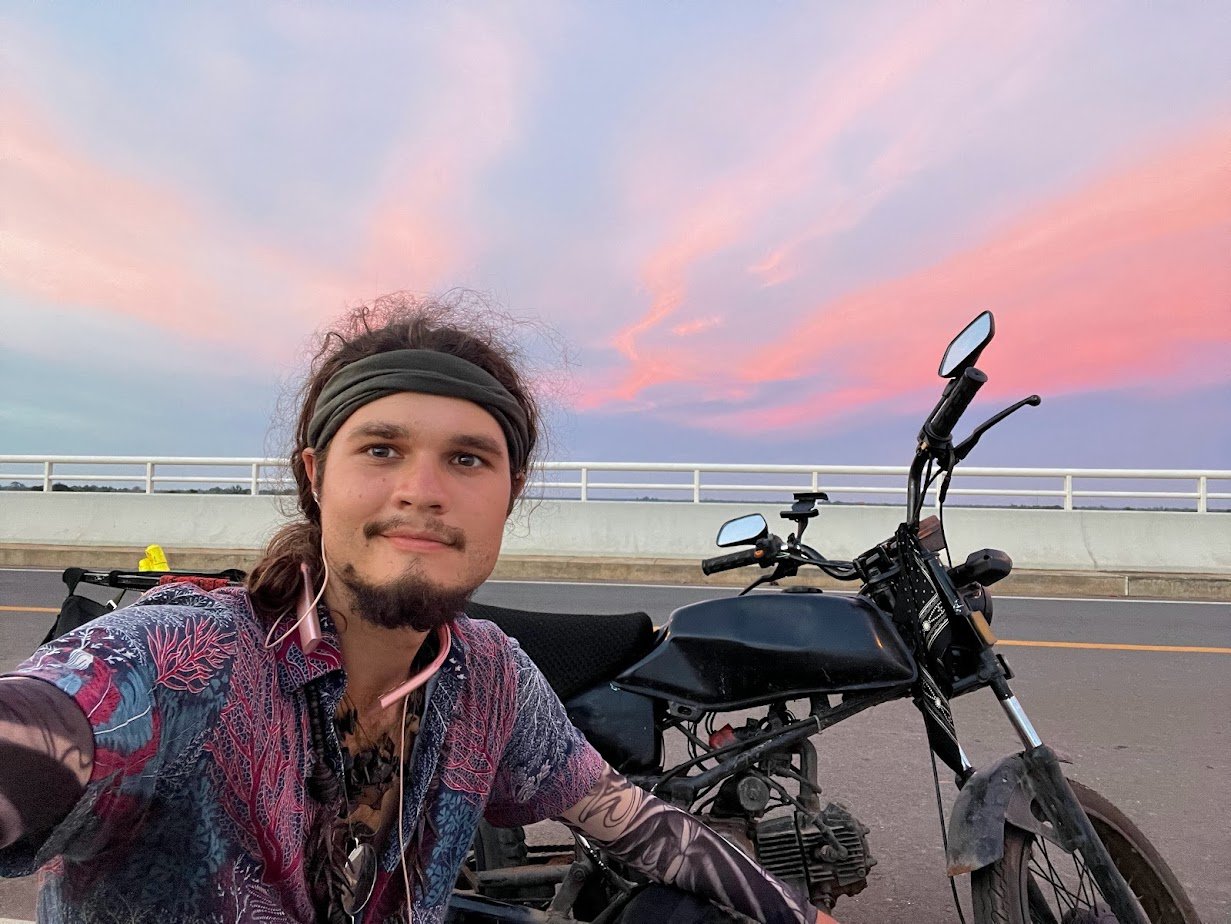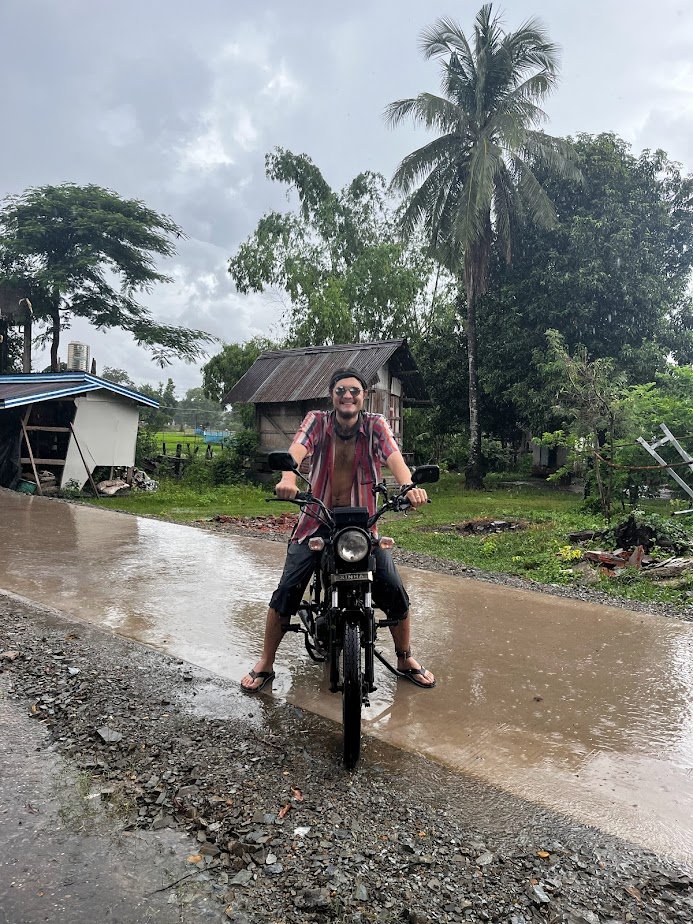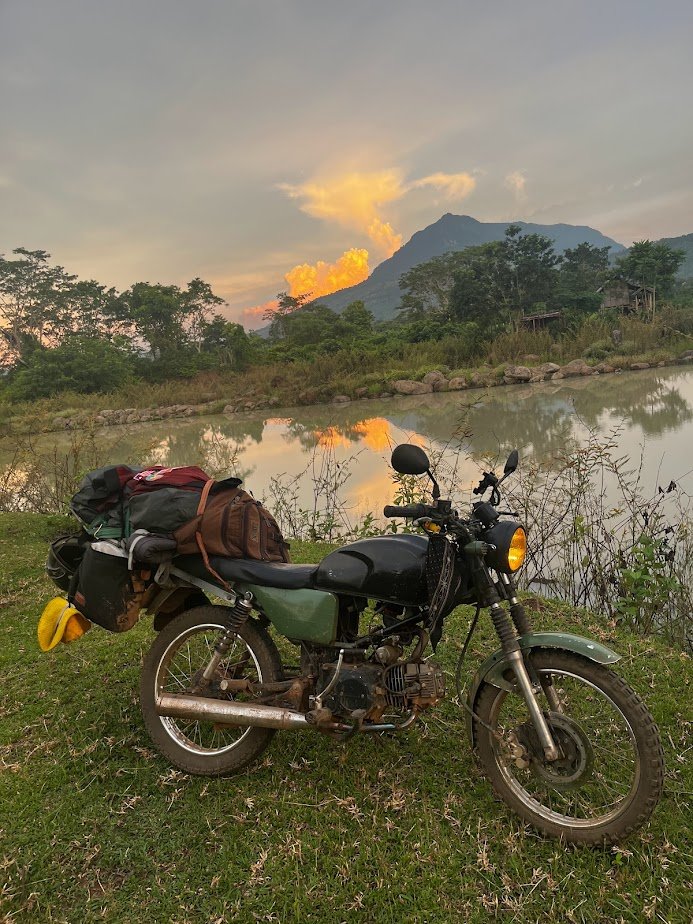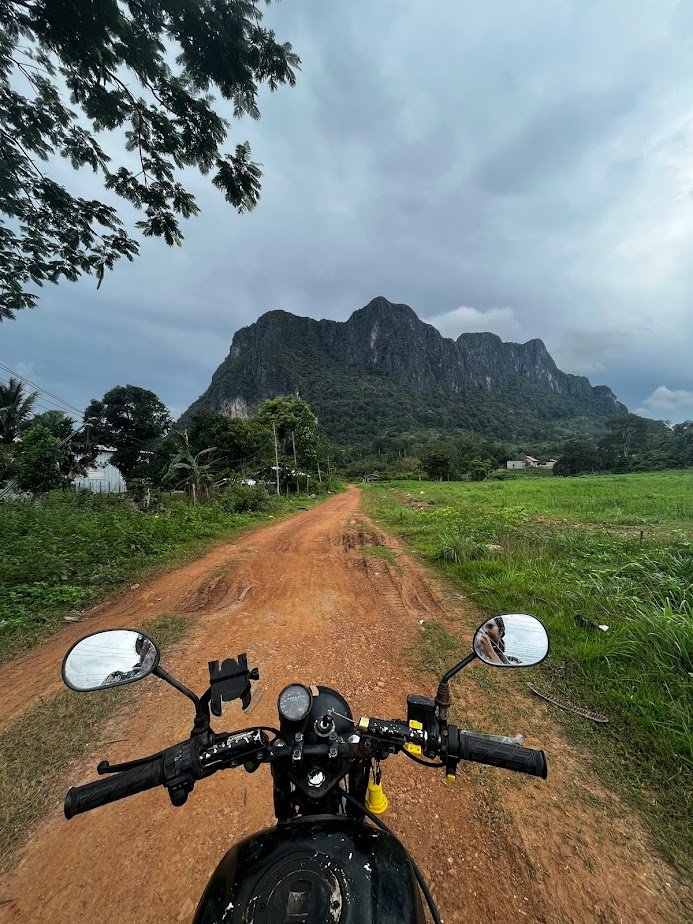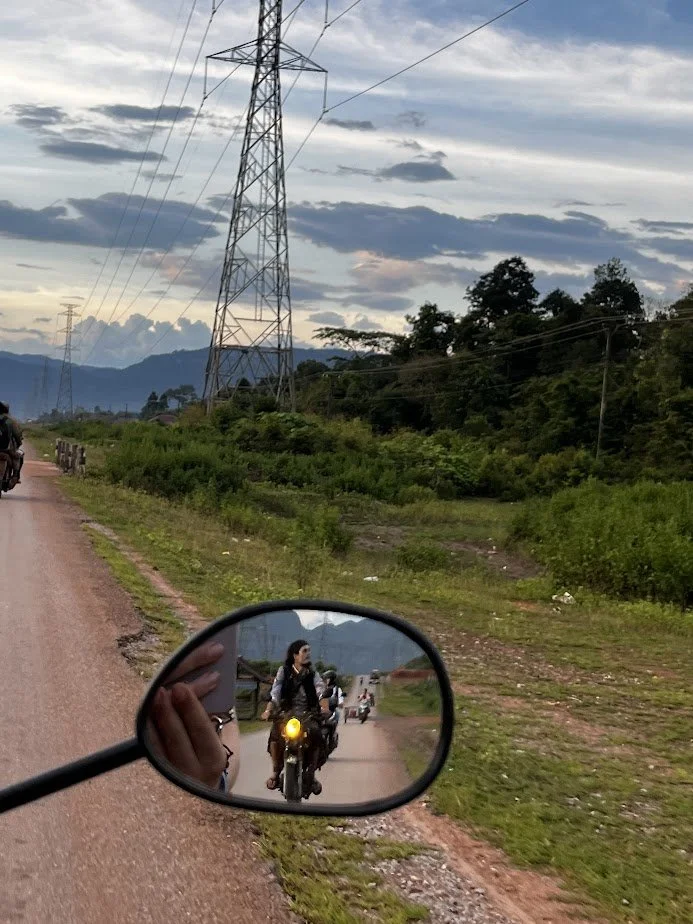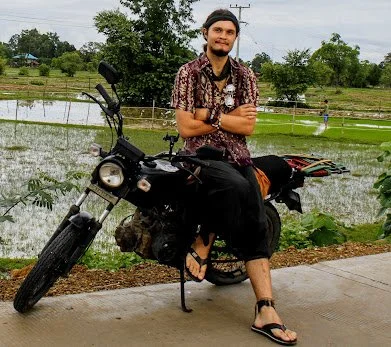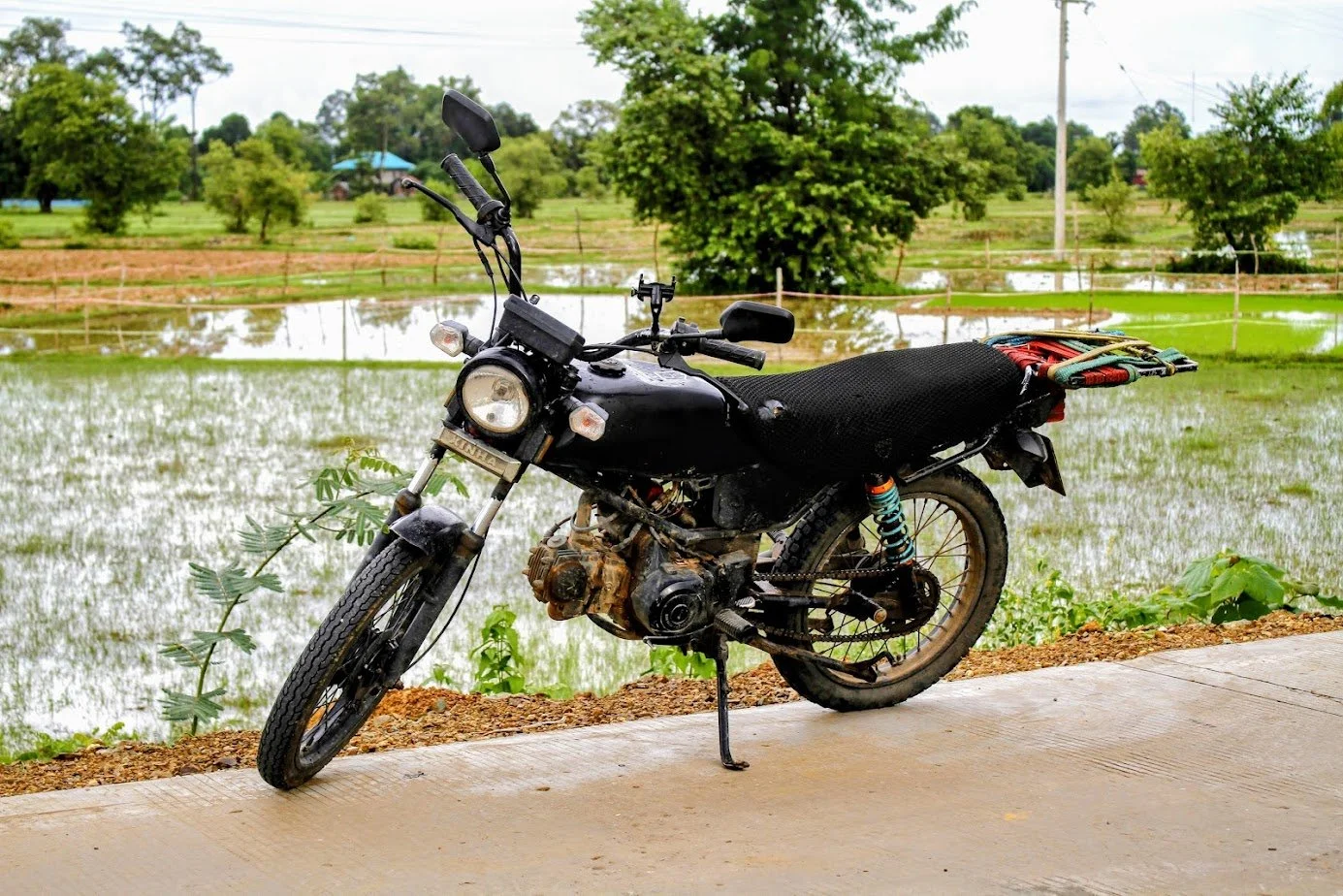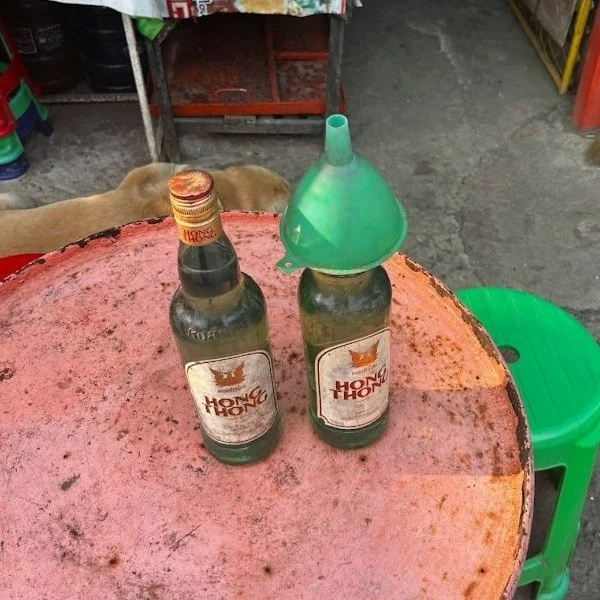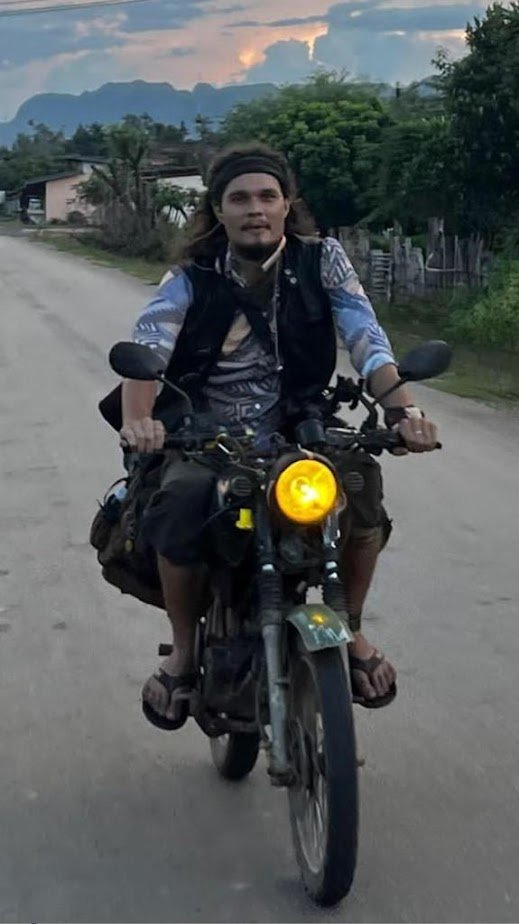Bikes, Bribes & Breakdowns
Introduction
Recommended listening [motorbike riding vibes]: Motorbike Playlist: Revamped
Alternative recommended listening [relaxing vibes]: Backpacking Playlist
There was a brief period of time when I owned exactly three things: a backpack, a motorbike, and another motorbike. This was a good period of time.
My two motorbikes
Buying my First Motorbike
Throughout my travels I regularly rented bikes. Most notable in Northern Thailand, an experience I have already written about.
But even when traveling by bus, boat, plane, or train, I generally would rent a motorbike in each city/location visited. This allowed me to explore the area better, like in Koh Rong (a Cambodian Island) where I was able to drive from town to town via the beach.
My rented motorbike in Koh Rong. The trick is to ride right where the waves hit the water. If the sand is too dry the motorbike sinks and gets stuck, but you also need to avoid steering the bike into the ocean.
Taking a bus then renting a bike at each location is a great strategy, and is what most travelers do. But after my Thai motorbike trip, I realized that a lot of my best experiences happened in-between the bigger cities, in smaller towns and random locations that the busses don’t stop at.
It is nice to get on a 12 hour night bus at 11 pm, and wake up at 11 am in a new city, rather than 3-4 days of slower and more difficult travel on a motorbike, but those 3-4 days of slower travel are full of far more adventures than any bus ride.
Renting a bike long-term is an option, but last time it cost me around $230, and generally rented bikes need to be returned to the same location they are rented from. Buying a bike can be cheap in Asia, and to prevent myself from going in circles all the time, I decided to buy my own motorbike.
In Ho Chi Minh, the largest city in Vietnam, I found a Facebook marketplace post of another backpacker selling their motorbike for $300. I offered $250 and walked away drove away on my ‘new’ motorbike.
My first motorbike.
When I bought the bike (affectionately nicknamed ‘Lucy’), I had never ridden a manual bike before. I was handed the keys to Lucy in downtown Ho Chi Minh City and, let me tell you, it was a ‘learn quick or perish’ situation. The traffic required me to become very familiar with the bike very quickly.
This intersection is only a few blocks away from where I was handed the keys to my motorbike.
I eventually found a nearby park, and practiced not-stalling before setting out towards the Mekong delta in southern Vietnam.
Mekong Delta
I spent about a week and a half in the delta, relaxing, exploring and practicing on the motorbike in a slightly less busy area.
One of my favorite places to practice riding and explore was this area around Can Tho. Small tributaries created a dense labyrinth of rivers. Along these rivers were narrow paths, similar to American sidewalks, flanked by houses. No cars could pass in this area, the paths were just wide enough for motorbikes to drive on. Access to these houses was limited to motorbike and boat; vehicles most households had multiple of.
This is apparently the only picture I took of the area, notice the river on the right and the fence (with a house on the other side) on the left.
A few other short stories about my time in the Mekong Delta:
-
As mentioned in past posts; I would like to buy a boat. At a floating market where boats shipped in products for vendors and households alike to buy a boat caught my eye. It was the perfect size & condition (no paint and a leak in the bottom that required semi-regular bailing of water - I know that sounds rough but I’m on a budget here).
I asked “How much to buy this boat?” but the language barrier proved impenetrable, for even enthusiastic charades.
As a last resort, I got out google translate. I typed in “How much to buy this boat?” The owner looked at the message and typed something back. This translated to “No one wants to spend time with my mother”. Obviously something went wrong in the translation somewhere.
I am often asked how I communicate with people. This story illustrates one of the faults of using a translate app. Another is that typing on the phone and passing it back and forth is much less engagement with the other person. I would much rather get an imperfect method across with charades than get a slightly-less-imperfect message across by typing it out and using translation software.
The exception to this improvisational sign language is prices. Prices are negotiated using calculator. Type in your offer and the seller clears and types in their offer. This repeats until a settlement is reached.
-
I have eaten many weird fruits. There are not many that I haven’t eaten, so when I found this bright Yellow/Orange melon at a market, I had to buy it. I did ask if it was ok to eat and got a yes, so I scurried off to a corner and enjoyed my breakfast.
The first notable thing is the color, then the spines - this is covered in sharp lil thorns.
I peeled the first layer off and tasted the yellow flesh underneath. It was utterly terrible and very bitter.
I dug deeper and found some red flesh. It was edible but still not delicious, sort of a sad cucumber flavor. It was also very striking in color and texture. A deep crimson red, it felt like I was butchering a small animal. It came out in small lobes, about the shape of a heart and connected to each other with a network of what looked like blood vessels. Adding to this sensation, it was warm from the equatorial sun.
I ate the entire melon, because:
I paid for it
I didn’t want to waste it
I was hungry
This turned out to be a bad idea. For the next three days I had bright red coming out both ends. The last time I had digestive issues I wrote a poem about it. This time I will be doing no such thing, but it was a rather unpleasant experience.

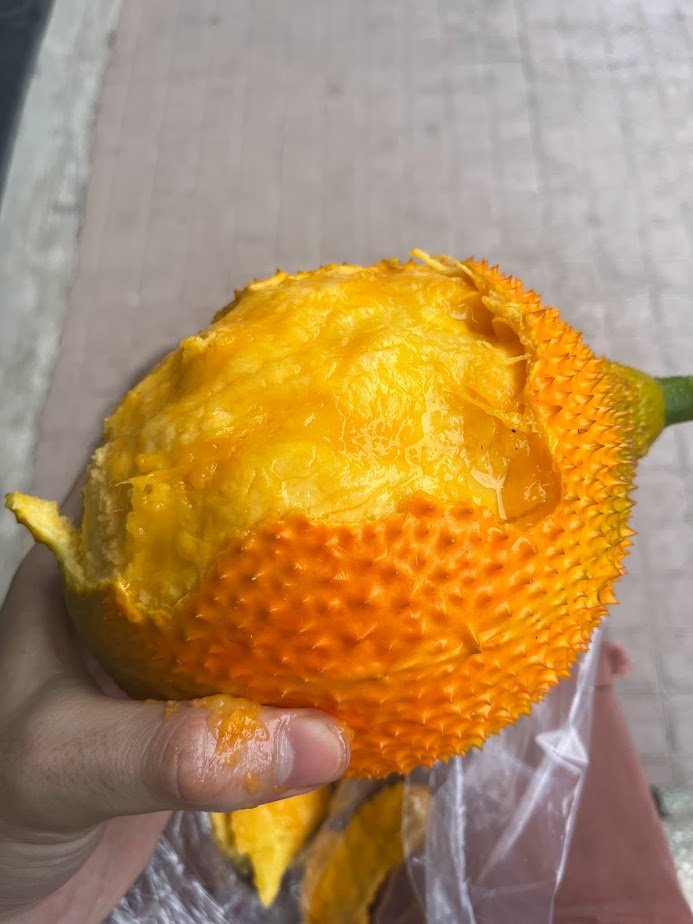
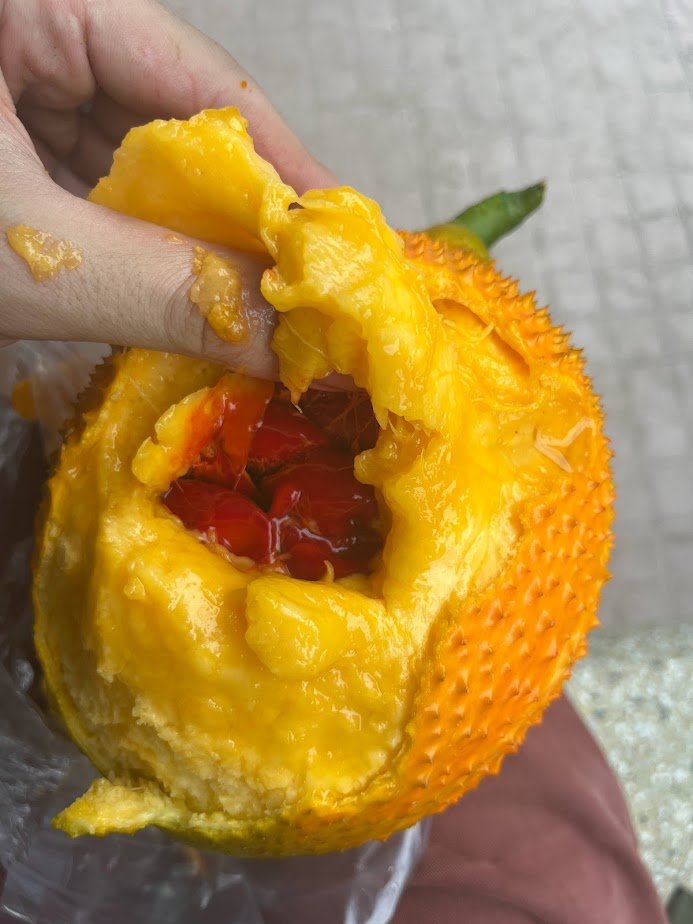
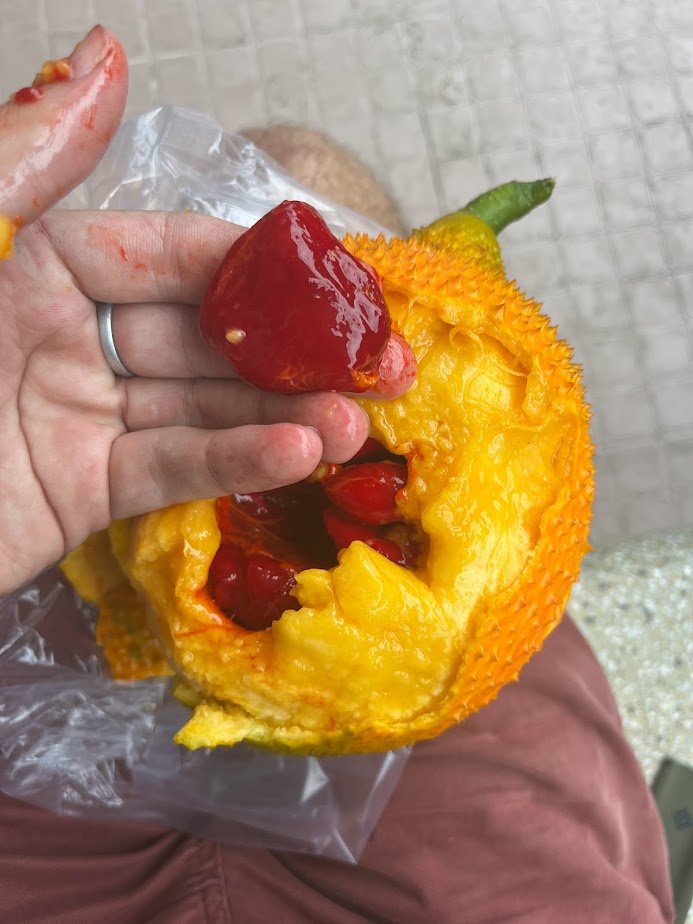
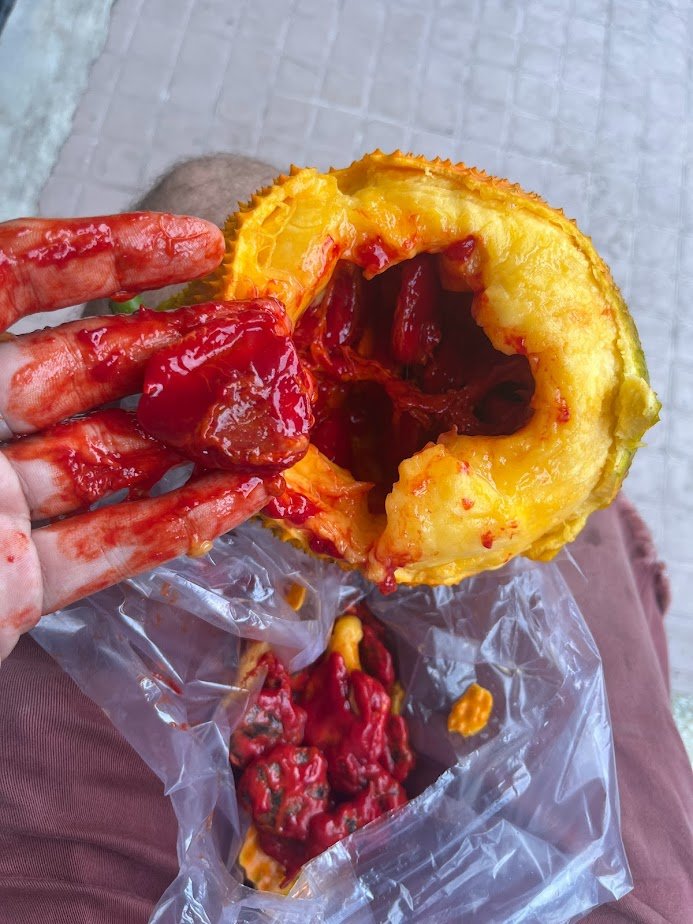
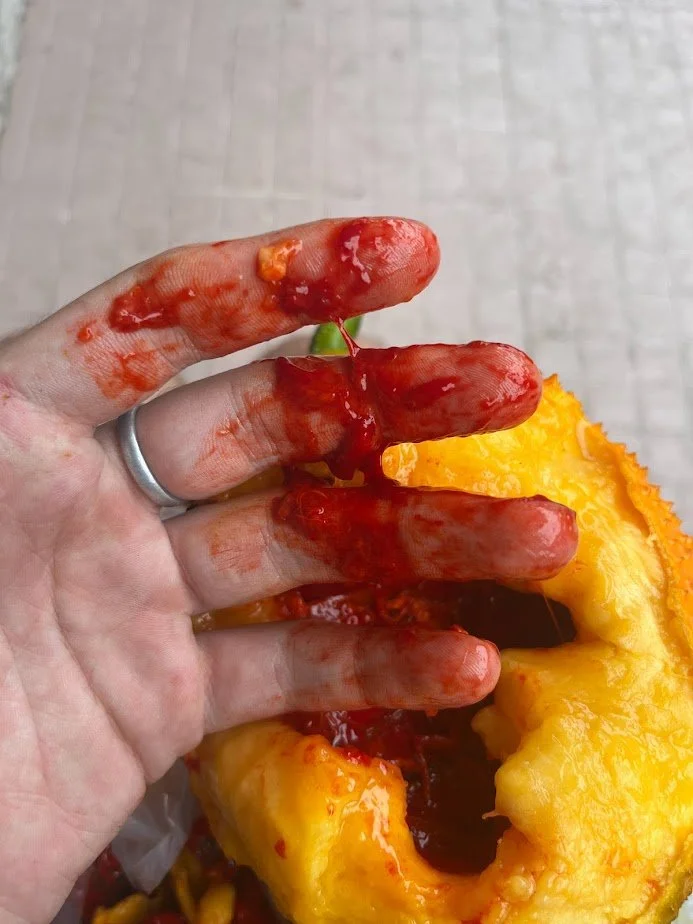
Border: Vietnam & Cambodia
Purple line: rough goal
Orange line: very roughly actual path
From the Mekong Delta I headed North. The original plan was to continue North in Vietnam, but I only had a 30-day Visa and was running low on time, so I decided to detour over to Cambodia, and travel through Western Cambodia, then go north through Laos.
Notice the orange line crosses a few country borders. This is also not possible with rented bikes, but is with bikes that you own (and are registered in Vietnam).
These borders ended up being rather difficult to cross. I first approached The Binh Hiep border cross and the Vietnamese side would not let me leave the country. They redirected me to the Moc Bai crossing, a 3-ish hour drive away.
Purple line: rough bike path
Red X: Binh Hiep border crossing
Blue X: Moc Bai border crossing
It was rather surprising and somewhat uncomfortable to be denied exit of a country. It happened because I attempted to exit at Binh Hiep after specifying a different exit crossing. Vietnam requires you to list your entry and exit ports when you apply for a visa. Unfortunately the crossing I specified in the visa was in the far north of the country, much farther than I could get with the remaining time I was allowed in the country. Moc Bai was also not the specified exit port, but it is the main Cambodia/Vietnam crossing point and sees more travel. The guards must be used to papers not lining up exactly because they let me through without problem.
This is the road between the two border crossings. I saw few other people and the road went on both sides of the Vietnam border. It would have been incredibly easy to cross the border at an unsanctioned crossing.
Border: Cambodia & Laos
The next border was even more difficult to cross. There is only one border crossing between Cambodia/Laos and it is notoriously corrupt. I can confirm this is the case. I expected to pay $35 USD to cross the border and ended up paying around $90 USD.
Below is a list of the expenses I incurred at the border.
-
On the Cambodian side I got my passport stamped and luggage X-rayed but they also sent me to a ‘motorbike room’ where I was expected to produce a paper motorbike registration that I was reportedly given upon entry to Cambodia. I was given no such paper. I am not entirely sure if this paperwork was real or fake.
I was sat alone in this office with a Cambodian man. After a few minuets of silence, he sigh deeply. Then sighed deeply again. I apparently was not getting the hint because he then said;
“We have problem. You have no paper.”
after a pause
“You have money?”
I answered
“Yes, but only little money”
“$20 make the problem go away.”
I ended up giving him $10 and was let through the border.
-
Online, the visa cost to enter Laos for an American is stated as $35. This is the only expense I expected to pay.
-
The visa cost me $40 instead of $35. This was counter to what the official government webpage said, so I think the agent pocked the extra $5.
-
I bought a Laos SIM card so I could access the internet and look at conversion rates between currencies.
-
Passport photos were required for the visa and were offered for $2.
-
Bribe to the official to actually stamp the passport. He asked for $2, but I read online you could not pay this bribe. He wouldn’t stamp the passport without it though, so I threw the remaining change in my pocket towards him, about $1.34.
-
Motorbike Registration in Laos. I am also not sure if this was real or another bribe. I was given some paperwork, but this could have been random scraps collected from the office wastebin: I can’t read Lao.
-
This office only accepted Laos, Cambodian, or American currency. I had with me $40 in American dollars (I usually caried $200 but just spent that on a motorbike), $5 in Cambodian Riel (I was leaving the country I didn’t need it), and $2 in Laos currency.
I thought this would be plenty to cross the border. It was not.
Luckily I had leftover cash in Thai, Singaporean, and Indonesian notes. I was able to exchange these with the same women I bought the SIM card from. She offered terrible exchange rates, but I had not choice but to accept.
Editors Note: there was no ATM or anywhere to get money at the border. Earlier in the trip I did not have enough money to cross a border and I was allowed to leave my passport at the border and take a taxi to a nearby ATM then return and pay the fee. This was not an option here. Instead the Laos officials were adamant I should go back to Cambodia if I couldn’t pay.
This wouldn’t work as I was already checked out of Cambodia and didn’t have the money for a new visa there either. Online, I have found reports of a scam where the border officials trap people in no man’s land between the borders if they don’t have the money for a visa. They are trapped until a guard ‘graciously’ offers to purchase their motorbike [for a fraction of what it is worth] so that they can pay for the visa. I was uncomfortably close to this happening to me.
The whole process took an hour or so but afterwards I was in Laos, with my motorbike, and had checked off an item from my bucket list: bribe a government official.
My 2nd Motorbike
When I made it to Laos I went almost immediately to Don Det, an island in the Mekong River.
-
Don Det is a lovely place full of traveling hippies. You are able to bring your motorbike via ferry, and it is off the beaten trail. The other people on the island are all grizzled explorers with stories of their own. Its a place where most of the non-locals there have been traveling in time measured in years rather than months, weeks or days.
The island was dotted with cafes and bars and was small enough that after a few days you got to know everyone. Days were spent drinking coffee, playing chess, and discussing philosophy. The evenings were spent doing much the same, but drinking beer instead of coffee.
Because everyone was more-less trapped on the island (the ferry cost ~$10 for a 2 way trip, that is a full day’s living expenses), there was a tangible sense of community. In all of Asia, I was never able to open a tab, but after a week on Don Det, I had tabs at 3 different bars.
The island had no police force of it’s own and mainland police rarely visited and gave warning each time, so although marijuana is illegal in Laos, plants could be spotted growing on porches and in cafes. The pace of life was much slower than on the mainland and more relaxed.
In typical Laos fashion, everything was very cheap. While I was there a fellow traveler rented an entire house in the downtown of the Island for one year for $300. I spent $3 for a room with air conditioning, that had a private porch right on the river. The hotel also had a cafe/bar and by noon the innkeeper was usually half a joint and two beers in, playing pool at the bar area.
It was very hard for me to leave Don Det.
While relaxing and writing at a chill island cafe, a man on a motorcycle pulled up the bar (every cafe doubled as a bar). A motorcycle nicer than mine. The man tried to sell the cafe owner/bartender/innkeep his motorcycle for $300. The owner/bartender/innkeep was not interested but the motorcycle seller was visibly stressed. His Laos visa expired the next day and he had a plane ticket out of the country.
I looked it over and told him to come back to me if he really couldn’t find a buyer. A few hours later I get a text: “name your price” I walk away with a 2nd bike for $150. I didn’t really need a 2nd motorbike, but for $150 I could hardly say no.
The new motorbike
I bought the 2nd bike and brainstormed what to do with two bikes.
A few days later I sold my first motorbike for $200 to another traveler on the island.
I was able to sell the new bike for a profit. I ended up making a profit on the bikes overall.
Breakdowns
Another reason I was ok with selling my first bike is that it was having regular breakdowns. I purchased it for $250, so I didn’t expect a perfect bike, but things were constantly breaking.
Chart of Broken Parts
Red means the part is broken. The X-Axis is time, each cell is about two days. This chart starts on June 5th when I bought the motorbike and ends on July 3rd, when I sold it.
It was sold to me as a “Honda Win Detech”, this is a bike that is a ripoff of the Honda win. But the bike was also not made by the Detech company, rather a Chinese company called ‘Vinstar’ that I couldn’t find any information online about. So I think the bike is a ripoff of a ripoff, a cheap copy of a cheap copy. A bike rental company has this to say about this model of bike:
”Tigit Motorbikes started as a Honda Win dealer and we ran away from this horrible and dangerous market. The Honda Win catches fire, brakes fail and it wobbles around with no stability, control or handling… A $600 piece of garbage that is so bad, it does not exist anywhere else in the world.”
The whole article goes on like this, for pages. So I did expect a few problems, but not the constant barrage that I found myself with. To the bike’s credit it always kept driving, but never was completely functional.
A Gallery of Repair Shops
I ended up at stopping at more repair shops than gas stations. I also had to jerry-rig some quick fixes, including using medical tape and hairbands to secure a flashlight to the handlebars because the headlight had broke. Luckily each fix was incredibly cheap, costing between $0.25 and $5.
It is possible to get gas at non-gas stations. Gas was readily available from old glass bottles and from manual pumps made from barrels along the road.
The second bike ended up being better at not breaking. Although immediately after purchasing it the throttle broke and had to be zip-tied together for me to drive to a repair shop. It also had a loose chain that and fell of a few times, despite me regularly stopping to get it tightened. Foggy (the new bike’s nickname) also had a broken odometer, speedometer, back blinkers, and tail light the entire duration of me owning it. And briefly the lens of the headlight fell off.
Later on my accidental jungle trek I broke the handlebars so badly that they required welding back on the bike. I also put a hole in the gas tank in that accident So for a while I was carrying gas in plastic bottles strapped to the back of the bike rather than the leaky gas tank. But after a weld (and small explosion) the gas tank leak was limited to a slow drip, that fixed itself after a week or so.
Froggy was not perfect, but it was far less annoying to drive, as the things that were broke stayed broke and the things that were working stayed working (unless I tipped the bike over repeatedly, but that was less annoying as it was my fault). It also went a little faster, had a bigger gas tank, and was a little louder. It was a good purchase.
Conclusion
-
Vang Vieng was a party town, past it’s prime. There are still bars that have menus for drugs; everything from weed to ketamine to opium can be bought as easliy as a beer. The drugs can be used in the bars freely, but can’t be brought outside the bars.
Warning signs of $500 fines, stories of strip searches, and local warnings were sufficient deterrence to corral drug usage into the confines of bars.
It didn’t used to be this way. Locals, innkeepers, and out of date tourist guides told stories of a time when every street was lined with half-naked partiers. The entire town and river it’s built on was a nonstop raging party, all the time.
But in 2011, 27 people died in one tourist season and some more enforcement started happening, limiting the drugs to within the premises of specific bars and discouraging activities like tubing down the river with alcohol.
-
Institutions are generally much weaker in Southeast Asia than Americans are used to. This is especially noticeable in Cambodia and Laos. Nearly every problem can go away with a bribe of around $5.
This is true for bartenders, border officials, and the police. Road construction was also very rough and scams abounded. It is a very different experience than living in a place like the United States or Singapore.
This story ends in Vang Vieng, Laos, on August 3rd. I had a plane ticket out of the country on the 14th and decided to start looking for a motorbike buyer, figuring it would take me around a week, and if I wasn’t rushed I could get a better price. The very first person I asked in the bar that night decided to buy it. I asked for $400 and he ended up giving me $375. I ended up making a profit on my purchased motorbikes.
Traversing by motorbike was an incredible experience. I got to see so many smaller places not frequented by tourists and experience a lot more of the area than traveling by more traditional methods could provide. The feeling of freedom was also unequaled. I could drive wherever I wanted for as long as I wanted.
Looking back on my year in Asia, this is the part that I remember the fondest, exploring on my motorbike. It inspired to me to get my American motorcycle endorsement and international drivers license (now I am legal to ride motorbike in 150 countries - on this trip I was driving illegally the whole time). In the future I am entirely sure there will be more motorbike trips.



